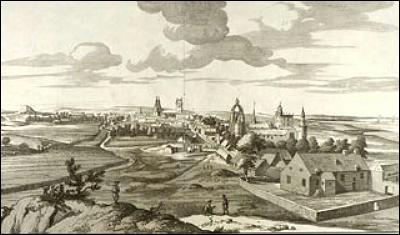
Aberdeen in the 17th century.

His parents were Thomas Burnett and Margaret Johnson or Johnston.
He is said to have come to America in 1635 aboard the ship Abraham of London when he was twenty-four, as a merchant. (See John Burnett I and Lucretia Johnson.)
He married Lucretia Johnson or Johnston, who may or may not have come from Aberdeen as well. One source on Ancestry.com says she was born March 22, 1629, in Essex County, Virginia. Another page from the same source says their marriage took place in 1657 in Essex County (and also says John Burnett died in February 1685 rather than 1696.)
They are said to have had at least five children including John, born in Virginia in about 1660; Charles, born about 1670; Sarah, born in 1670; Thomas, born in 1665, and Phebe, birthdate unknown, died 1709, the same year in which her mother died. (Lucretia Johnson's will mentions four: John, Thomas, Sarah, and Phebe, but implies Phebe is dead. See Lucretia Johnson.) (Also see Descendants of Alexander Burnard of Scotland.)
His wife was was about nineteen years younger than he. If they married in 1657, she would have been twenty-seven or twenty-eight, he forty-six or forty-seven. she would have been thirty or thirty-one when her oldest known child was born in Virginia, and her husband would have been forty-nine or fifty.
What might explain why they started their family so late in life (if there's no mistake in the data)?
An explanation might arise from the turbulent history of Aberdeen in the middle 17th century. Royalists and Covenanters occupied and re-occupied the town between 1639 and 1646, usually with bloodshed, in a conflict related to the English Civil War between Parliament and King Charles during the same period. (See below.)
John Burnett's father and uncle were killed by Royalists during or after the Battle of Justice Mills in 1644.
He made his first trip to Virginia in 1635, and seems to have made at least one more voyage home to Aberdeen and back to Virginia, presumably after receiving a warrant in 1638 to carry on trade between Aberdeen and Virginia.
He would have had good reason to avoid Aberdeen while the conflict raged, and even more after his father's death in 1644 and the outbreak of plague in 1647. Did his future wife somehow live through these catastrophes? Or was she in Virginia the entire time? Perhaps before marrying John Burnett she had lost a husband and children in the catastrophes in Aberdeen, or in Virginia.
According to the page John Burnett Sr, John Burnett was listed among “persons of quality” aboard the ship Abraham of London, of which John Barker was master. He arrived October 24, 1635. The author of the page, named as Gene 4.3.4, speculates "this may have been a first visit to Virginia to survey the situation prior to bringing his own ship with supplies from England and Scotland prior to receiving the warrant from the King."
That warrant or license was granted July 2, 1638, by King Charles I: "Warrant from the King to the Governor of Virginia or other officers whom it may concern for John Burnett of Aberdeen, the sole merchant of our Kingdom of Scotland, that hath supplied the plantations of Virginia and become Our tenant there, and his factors to have free commerce and traffic between Scotland and Virginia." The author of the page says the cargo John Burnett shipped to Scotland was primarily tobacco, and implies he made more than one voyage.
In the same year, the National Covenant, opposing the political and ecclestiastical reforms of Charles I, was signed at Edinburgh. The Burgh of Aberdeen was alone in rejecting the Covenant. The Earl of Montrose's Covenanter army occupied Aberdeen at the end of March, 1639, and Aberdeen subscribed to the covenant on April 10. Royalist troops occupied Aberdeen on May 15, and Montrose re-occupied the town and seized its armaments.
This conflict would, five years later, culminate in a battle for Aberdeen in which John Burnett's father and uncle would die.
On June 6, 1639, the Royalists re-occupied Aberdeen. Then on June 18 and 19, Aberdeen militia and Royalist cavalry fought Montrose’s Covenanters in the Battle of the Bridge of Dee, which ended with Aberdeen again taken for the Covenanters.
After further re-occupations, Royalists and Covenanters fought the Battle of Justice Mills (or Fecht of Aberdeen) on September 13, 1644. The Royalists clashed with the defending Covenanter forces of Lord Burleigh and the Burgh Council of Aberdeen. Montrose (now a marquis) had gone over to the Royalists and led the Royalist attack at the head of some 1,500 troops The Covenanters had about 2,500 men.
The Covenanters sought to block Montrose at the hill at Justice Mills. Montrose sent word to the Covenanters that those who resisted would receive no quarter. When his messenger was killed while returning with a reply, Montrose attacked and broke the opposing force. Montrose allowed his troops to plunder Aberdeen, and the Council Registers say that “the enemie entring the toune immediatelie, did kill all, old and young, whome they fand on streittes.”
Aberdeen was occupied by a Covenanter garrison for most of the rest of the decade, although much of the town was burned and plundered by the Marquis of Huntly’s Royalist army in May 1646.
(This information is taken from a history entitled "The Battle of Justice Mills" on the Aberdeen City Council website.)
John Burnett's father Thomas and uncle Andrew, burgesses of Aberdeen, were killed during the battle or in its aftermath Aberdeen. More than one hundred and fifty burgesses were killed. (See the page Thomas Burnett.)
Three years later, in 1647, an outbreak of plague killed about a quarter of the remaining inhabitants of Aberdeen. (Wikipedia, History of Aberdeen.)

Aberdeen in the 17th century.
